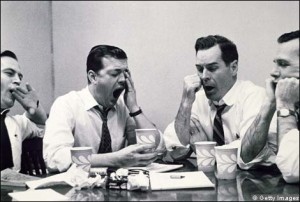YAWNING
IX. Control of Yawning
A. icv injections of ACTH or a-MSH
1. induce both stretching and yawning
a. rats, rabbits, cats, dogs
i. systemic ACTH / a-MSH also Þñ stretching & yawning
2. blocked by MC4 antagonist
B. Intra-PVN ACTH or a-MSH Þñ stretching and yawning
1. also effective in dorsomedial and ventromedial hypothalamus
a. latency Þ 15 - 35 min
b. lasts 90 min
2. blocked by MC4 antagonist
3. \ PVN MC4 activation Þñ stretching + yawning
C. \ arousal Þñ arcuate ACTH & a-MSH ÞñMC4 PVN ÞñNST
D. PVN OT neurons Þ Amygdala, Hippocampus, VTA
1. OT Þñ VTA Þñ DA in NAc
a. OT Þñ Hippocampus Þñ Glu Þñ VTA Þñ DA
in NAc and mPFC
i. Ventral Subiculum
ii. inhibited by opioids and GABA
b. OT Þñ Amygdala Þñ Glu Þñ VTA Þñ DA in NAc & mPFC
i. pMeA
ii. inhibited by opioids and GABA
2. ñ DA in NAc & mPFC Þñ arousal
3. OT Þñ VTA Þñ DA in PVN Þñ OT
a. self-reinforcing circuit
i. increases the likelihood of yawning
E. Catecholamine activities modify OT, ACTH, a-MSH-induced yawning
1. b adrenoreceptor antagonist + OT Þññ yawning
a. b adrenoreceptor antagonist + a-MSH Þññ yawning
i. b antagonist alone does not affect yawning
1) b adrenoreceptor antagonist Þ X Gs/cAMP
2. D2 receptor antagonist Þñ yawning
a. D2 antagonist + a1 adrenoreceptor antagonist Þññ yawning
i. D2 antagonist + a1 receptor agonist Þò yawning
1) D2 antagonist + a2 antagonist Þò yawning
a) D2 & a2 antagonists Þ
Þ X Gi neg feedback
b) a1 agonist Þñ Gp/PLC/Ca++
ii. D2 antagonist + b antagonist Þññ yawning
F. ACh - cholinergic systems also may Þñ yawning
G. Yawning requires: Recurrent Self-Reinforcing Arousal Circuits
+ Inhibition of Parasympathetic activity & Swallowing
1. SCN VIP & AVP Þñ VPAC1 & V1A ARC Þñ ACTH & aMSH Þ
Þñ MC4 PVN Þñ OT Þñ OT-R NST & LC
a. ñLC NE Þñ a1 ARC Þñ aMSH Þ
Þñ MC4 PVNÞñ OTÞñ NST & LC
2. ñPVN OT Þñ OT-R hippocampusÞñ Glu Þñ AMPA/NMDA VTA Þ
ñ VTA Þñ DAÞñD1 PVN Þñ OT
a. DA Þñ D2 PVN Þò DA release
i. Þò D2 PVN Þñ yawning
b. ñPVN OT Þñ OT-R amygdala Þñ Glu Þñ AMPA/NMDA
VTA Þñ DA ÞñD1 PVN Þñ OT
3. NE Þñ a1 & b2 Vagal nucleus Þñ parasympathetic output Þ
Þò HR & BP
Þñ swallowing & digestion
a. where the a1 & b adrenoreceptor antagonists
facilitate OT-induced yawning
4. NST Þñ C8-T2 preganglionic sympathetic ACh Þñ SCG
ñ SCG Þñ postganglionic sympathetic NE
a. swallowing:
NST Glu Þñ AMPA/NMDA hypoglossal nucleus Þñ ACh
ñ ACh Þñ Nicotinic-R pharyngeal striatal muscle contraction
i. ambiguus nucleus
ii. trigeminal nucleus
iii. facial nucleus
b. opposing NST Þ pharyngeal actions
5. Inhibition of Swallowing is necessary for Yawning
a. 80% of swallowing happens during the expiratory phase
of respiration
b. NE ÞñNST a2 receptors Þò swallowing
c. DA ÞñNST D2 receptors Þò swallowing
X. Efferent Yawn Output
